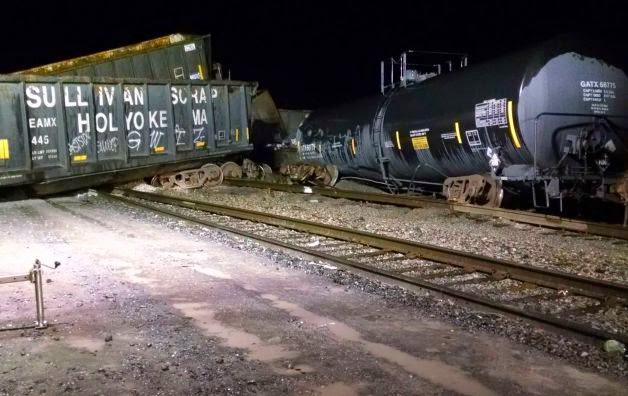TRAIN DERAILMENTS
CAUSED BY HUMAN ERRORS ARE IMPOSSIBLE TO PLAN FOR AND INHERENTLY THE MOST
DANGEROUS: A MISPLACED PIECE OF SAFETY
EQUIPMENT TRIGGERED THE SLOW-MOTION DERAILMENT OF 18 RAILROAD CARS ON
OCTOBER 23, 2014 AT THE SPRAWLING SELKIRK RAIL YARD
A misplaced
piece of safety equipment triggered the slow-motion derailment of 18 railroad
cars on October 23, 2014 at the sprawling Selkirk rail yard, the state Department
of Transportation said Thursday.
Eighteen
cars — two of which had been earlier emptied of highly explosive propane —
derailed about 7:40 p.m. at the sprawling Selkirk yard, which can handle
thousands of freight cars a day for rail company CSX and is a critical transit
gateway to much of the Northeast. No cars ruptured or spilled, and no one
was hurt.
State
transportation investigators said the mishap was caused by safety equipment —
called a derailer — inadvertently left on the tracks by a crew that had been
making repairs. A derailer is meant to protect workers by blocking trains from
running over them.
Another
worker elsewhere later began using a remote-controlled engine to move freight
cars slowly around the yard, unaware the derailer was in the path of the
oncoming cars, according to a DOT statement.
"The
remote control operator was moving freight cars onto that section of track when
they ran into the derailer, pushing them off the tracks. Investigators believe
the remote control operator was initially unaware of what was happening and
continued to move the cars down the track, causing more to derail,"
according to DOT.
Albany
County Executive Dan McCoy said the accident, coming days after a liquid
propane spill at a tank farm near a sprawling interstate highway intersection,
shows the Capital Region is "dancing with the devil" as fossil
fuel-laden trains surge through from the Midwest.
Fifteen of
the cars in Selkirk had been righted by Thursday afternoon, said CSX spokesman Rob
Doolittle. He said four cars were classified for hazardous materials, including
two for propane, as well as one containing residue of a chemical herbicide and
another containing an industrial acid.
Doolittle
said "several of the remaining cars were empty, and none of the other cars
contained any hazardous freight." He said the accident was not causing
backups or delays elsewhere on CSX lines.
A vocal
opponent of a surge of crude oil rail shipments from North Dakota that are
arriving daily in Albany, some carried by CSX, McCoy said the rail company was
"downplaying" the mishap and "making it sound like less than it
was." He and Albany County Sheriff Craig Apple went to the yard Wednesday
night to inspect the mishap.
Derailed
cars were "stacked two or three high," said McCoy. "There was a
huge crater or hole near one of the derailed cars ... and one car was leaning
against" a tanker that was marked with a placard identifying its contents
as propane. "Cars were beaten up, dented in. It looked like a bomb had
gone off."
State DOT
spokesman Beau Duffy said CSX notified the state at 8:23 p.m., within a
one-hour notification window required under law. He said previous state
inspections of the yard have "not found anything out of
the ordinary."
This is the
second derailment at the Selkirk yard this year. In February, 13 tanker cars
each carrying about 29,000 gallons of highly flammable crude oil derailed, but
did not spill or explode. DOT later fined CSX $5,000 for failing to notify the
state of the derailment within the one-hour requirement.
Later,
inspectors from DOT and the Federal Railroad Administration looked at a mile of
track in the Selkirk yard and found 20 "non-critical defects" that
were to be repaired, according to a March press release from Gov. Andrew Cuomo.
On Monday,
there was "a small release" of liquid propane from a tank farm in
North Albany, near the intersections of Interstates 90 and 787, according to
statement from tank farm owner Global Partners.
Workers
found the leak during a "routine site inspection" about 3:45 p.m.,
according to a statement by Global Partners Vice President Edward J. Faneuil.
The company informed the city Fire Department and burned off "excess gas
which could not be recovered," he said. No one was hurt and the cause of
the leak was being investigated.
McCoy said
flames from the gas burn went on for hours Monday night. City Fire Chief Warren
Abriel said his department was notified by Global about 5 p.m. that they were going
to burn off excess gas from one of its storage tanks. He said he was not aware
that burn was linked to a leak.
Burning gas
vented from tanks is a routine procedure at the Global facility that is not
unusual, said Abriel. Global expanded its 540,000-gallon propane storage
facility in April; it has been receiving propane shipments by rail there since
April 2013.
Spokesman
from both state DOT and the state Department of Environmental Conservation said
their agencies were not required to be notified about the propane spill.








